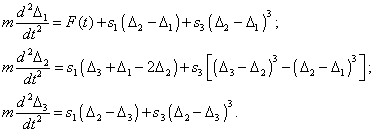| SELF | 30 |
S.B. Karavashkin and O.N. Karavashkina |
|
|
|
| 2. Statement of the problem
In order to concentrate just on the technique seeking
solutions for the nonlinear problem, let us choose as a study model a rather simple 1D
homogeneous finite line with unfixed ends (see Fig. 1) consisting of only three elements
connected by the nonlinear elastic constraints having the characteristic s ( |
|
Fig. 1. Mechanical model of three-body system of masses m
connected by a nonlinear elastic constraints whose stiffness coefficients depend on total
shift of the first and second bodies
|
|
Determining the pattern of the stiffness coefficient
dependence on the constraint deformation degree, we will not diverge from the standard
conception, according to which the nonlinear characteristic of an elastic constraint can
be presented as a power series in |
|
|
(1) |
| and "practically, in many cases two terms | |
|
(2) |
are sufficient. The cubic (not quadratic) term provides the similar value of the resetting force with positive and negative shifts" [17, p. 327]. Although, as we will show further, the limited distribution (2) does not have any effect on the approach itself to solving the problem (but only on the result conditioned by the correctly taken expansion coefficients in (2) in each specific problem), meanwhile we will use the conventional practice, and when expanding, confine ourselves to the cubic term. At the same time, we will not introduce an additional requirement of the smallness for s3 in comparison with s1, because in the course of investigation we will reveal that such condition inherent in all asymptotic techniques is excessive in the approach we use. Noting the above preliminary consideration and the results of [3], we can present the modelling system of differential equations as |
|
|
(3) |
We also will not complicate the regularity of external force and take it in a simple harmonic form |
|
|
(4) |
supposing that in the future investigations this regularity can be essentially complicated with the remaining validity of the approach to solving the problem. Finally, without limiting the generality, suppose that free vibrations are absent in the considered system, the more that with the settled motion only non-damping forced vibrations are practically important [18, p. 58]. Given (4) and all factors completing the definition of a model, (3) gains the complete determinacy and does not require any additional initial or boundary conditions. As we showed in [9]- [16] for different elastic line models, the completely determined systems of differential equations do not need completion of the definition, the same as the constants that need determination on the basis of initial or boundary conditions are absent in their solutions. In the absence of free vibrations and with the settled pattern of external force (4), whichever pattern of the reaction of the line to this affection we obtain, the location of any element of the system will be uniquely determined by this reaction to the given external affection. Giving additionally the initial conditions with the chosen form of modelling equations, we would simply double the conditions that we can obtain, substituting the value of the initial moment of time to the obtained solution. As opposite to this, should we use as the modelling system of differential equations a conventional form (see e.g. [12, p. 227]) |
|
|
(5) |
(where L = T - U is the
Lagrange function of the studied system, qi and An opposite statement follows from the said. Should we give the additional initial conditions, we would have to remain the amplitude and the external force phase in (4) indefinite, and to determine these parameters on the basis of yielded solution, matching them with the initial conditions of our problem. The same concerns the additional boundary conditions. Should we use (5) as a modelling system, the completing of its definition by the boundary conditions would be justified. However, as we showed in [2]- [9], in this case we would have to limit our study by the frames of matrix methods and characteristic equations. On the contrary, with the determined modelling system of a specific elastic line we gain the possibility to obtain the exact and complete analytical solutions that cannot be obtained by the matrix methods. However, with such specification of the system of differential equations, the necessity in additional boundary conditions falls away, as they are taken into account directly in the system; one can make sure in it, seeing the system (3). The absence of constraints at the ends of elastic line has led to the disappearance of the right-hand part summands determining the constraints of the first and third bodies with the previous and following bodies that are absent in a line correspondingly. With it the differential equations describing the dynamics of these non-existent bodies are absent too. Thus, the form of record of the system (3) in conjunction with (4) is fully determined with reference to the features of the studied elastic line, affecting external force and initial conditions. |
|

